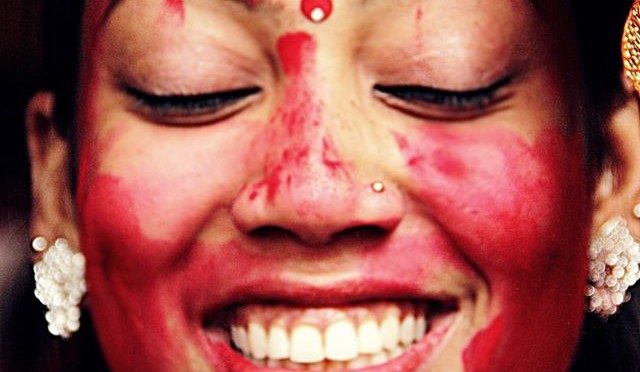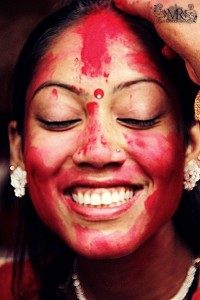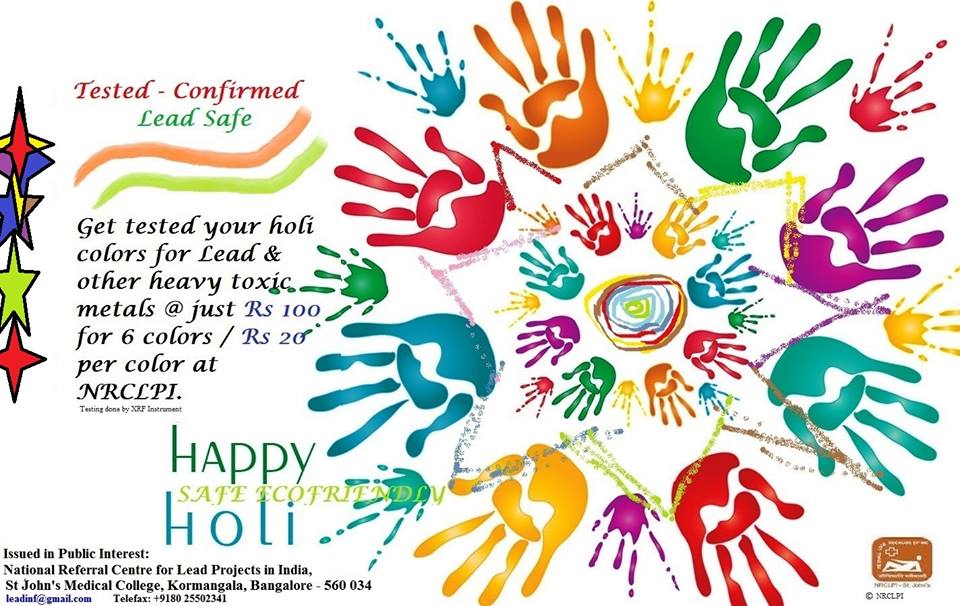
Celebrate eco friendly holi with toxic-free holi colours
Holi means the festival of colours, so there is no use preaching to stay away from the colours. It is a well-known fact that the colours of Holi stay on for more than a day, which means some of the colours are getting absorbed into the body. Hence opt for eco friendly Holi colours. Read this post to find out the benefits of vertical farming.
We see a large number of Holi colours in the market which may be toxic in nature, but we are unable to verify if the colours are toxic. So the best option is to buy branded, packed colours like Rangeela that mentions toxic-free colours on the packing. However, we tend to buy the unbranded colours because they are cheaper and brighter in colours
As the saying goes, ‘look can be deceptive’ – the brighter the colour, the greater the chances of presence of Lead which is a toxic element. There is a number of toxic element that is added to make the colours darker. [plain] TOXIC ELEMENTS USED IN COLOURS AND HEALTH HAZARDS
“Green colour is obtained from copper sulphate -which may cause allergies in the eye or even temporary blindness.
Purple is obtained from chromium iodide – which may cause bronchial asthma or other forms of allergy.
Silver is obtained from aluminium bromide – a known carcinogenic.
Black is obtained from lead oxide – may cause renal failures or learning disability.
Red is obtained from mercury sulphite – may cause skin cancer or Minamata disease (mental retardation, paralysis, impaired vision…)
Shiny Colours are a result of powdered glass being added to the colours.” – holifestival.org[/plain]Not only are the colours harmful to human skins, but also the environment. When the colours go down the drain, the toxic elements mix with the soil, the river and the air polluting the environment, endangering the flora and fauna, and adding toxic content in the vegetables.
Get the colours tested
If you are unsure of the toxicity of the colours and still want to buy them, test the product in some reputed institutions. One such institution that conducts toxicity tests for colours is NRCLPI (National Referral Centre for Lead Projects in India) in Banglore. “You can courier the sample,” says Mr. Vinay Kumar of NRCLPI. The test will ensure the eco-friendliness of the Holi colour powders.
How to prepare Holi colours at home
Always homemade eco friendly holi colours are the best choices to stay from any kind of malpractices and health hazards. Traditionally many families prepare organic colours at home using kitchen ingredients, leaves, tree barks and flowers that are available around the house. Not only are the raw materials eco-friendly, they have many health benefits too.
- The yellow colour is naturally available in turmeric to which you can add gramflour to increase the volume. You can also dry and powder chrysanthemums for the yellow hue.
- Dried and powdered Henna, Palak and leaves of Gulmohar can give green colour.
- Rose petals, red hibiscus flower, kumkum can be dried and powdered to get a red colour. Also, redcolour can be obtained from grated and boiled beetroot.
- Buy dried flowers from the market, soak them overnight to get a saffron colour.
- The brown colour is found in tea leaves.
Nowadays herbal colours made from extracts of flowers, tree barks and leaves are available in the market. As they do not cause health hazard they are in high demand. Sometimes the herbal holi colours are also scented using essential oils like lemongrass and orange.





You are a very clever person!
Thank you for sharing excellent informations. Your web site is so cool. I am impressed by the details that you?¦ve on this website. It reveals how nicely you understand this subject. Bookmarked this website page, will come back for extra articles. You, my pal, ROCK! I found simply the info I already searched all over the place and just could not come across. What an ideal web site.
Thanks for sharing superb informations. Your web-site is so cool. I am impressed by the details that you’ve on this site. It reveals how nicely you perceive this subject. Bookmarked this web page, will come back for more articles. You, my friend, ROCK! I found just the information I already searched all over the place and just couldn’t come across. What an ideal website.
Hi, Neat post. There’s a problem with your site in internet explorer, would check this… IE still is the market leader and a big portion of people will miss your great writing due to this problem.
Nice post. I learn something more challenging on different blogs everyday. It will always be stimulating to read content from other writers and practice a little something from their store. I’d prefer to use some with the content on my blog whether you don’t mind. Natually I’ll give you a link on your web blog. Thanks for sharing.
I as well as my guys appeared to be checking the nice tips on your web page and so quickly developed a terrible suspicion I never thanked the web blog owner for those secrets. My young boys had been absolutely passionate to learn them and already have actually been taking advantage of them. I appreciate you for turning out to be really kind and also for going for certain brilliant subjects millions of individuals are really wanting to know about. Our own sincere apologies for not saying thanks to earlier.
To the lifestyletodaynews.com webmaster, Your posts are always well-formatted and easy to read.
Hello lifestyletodaynews.com owner, Your posts are always well-delivered and engaging.
To the lifestyletodaynews.com webmaster, Your posts are always well thought out.
Hi lifestyletodaynews.com administrator, Your posts are always well structured and easy to follow.
Heya i’m for the first time here. I came across this board and I find It truly useful & it helped me out much. I hope to give something back and aid others like you helped me.
Hello lifestyletodaynews.com admin, You always provide great information and insights.
To the lifestyletodaynews.com owner, Good job!
Hello lifestyletodaynews.com owner, Your posts are always well received by the community.
Hello lifestyletodaynews.com owner, You always provide great examples and case studies.
To the lifestyletodaynews.com webmaster, Thanks for the well-organized and comprehensive post!
Dear lifestyletodaynews.com webmaster, Your posts are always well presented.
Hello lifestyletodaynews.com admin, Your posts are always well-written and easy to understand.
To the lifestyletodaynews.com administrator, Thanks for the informative and well-written post!
To the lifestyletodaynews.com owner, Your posts are always well-written and easy to understand.
Hello lifestyletodaynews.com owner, Thanks for sharing your thoughts!
Hello lifestyletodaynews.com admin, Great content!
To the lifestyletodaynews.com webmaster, Your posts are always well-written and easy to understand.
Hi lifestyletodaynews.com webmaster, Thanks for the great post!
Hi lifestyletodaynews.com admin, Good job!
To the lifestyletodaynews.com administrator, Thanks for the post!
Hello lifestyletodaynews.com owner, Keep up the great work!
Dear lifestyletodaynews.com owner, Thanks for the in-depth post!
Dear lifestyletodaynews.com administrator, Your posts are always well-referenced and credible.
Hi lifestyletodaynews.com administrator, You always provide useful tips and best practices.
Great write-up, I am normal visitor of one’s site, maintain up the nice operate, and It is going to be a regular visitor for a long time.
A person essentially assist to make significantly articles I’d state. This is the very first time I frequented your website page and up to now? I amazed with the research you made to create this particular put up extraordinary. Great activity!
Hi lifestyletodaynews.com administrator, You always provide in-depth analysis and understanding.
Fantastic goods from you, man. I’ve take into account your stuff previous to and you are just extremely great. I really like what you’ve obtained here, certainly like what you are saying and the way through which you are saying it. You are making it enjoyable and you still care for to stay it wise. I cant wait to read far more from you. That is really a great website.
I am glad to be one of several visitors on this great website (:, thankyou for putting up.
Hi lifestyletodaynews.com webmaster, Your posts are always well-written and easy to understand.
Hello lifestyletodaynews.com administrator, Your posts are always thought-provoking and inspiring.